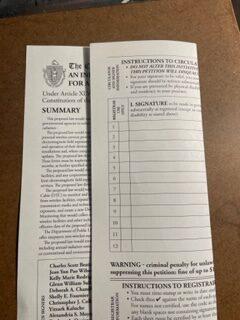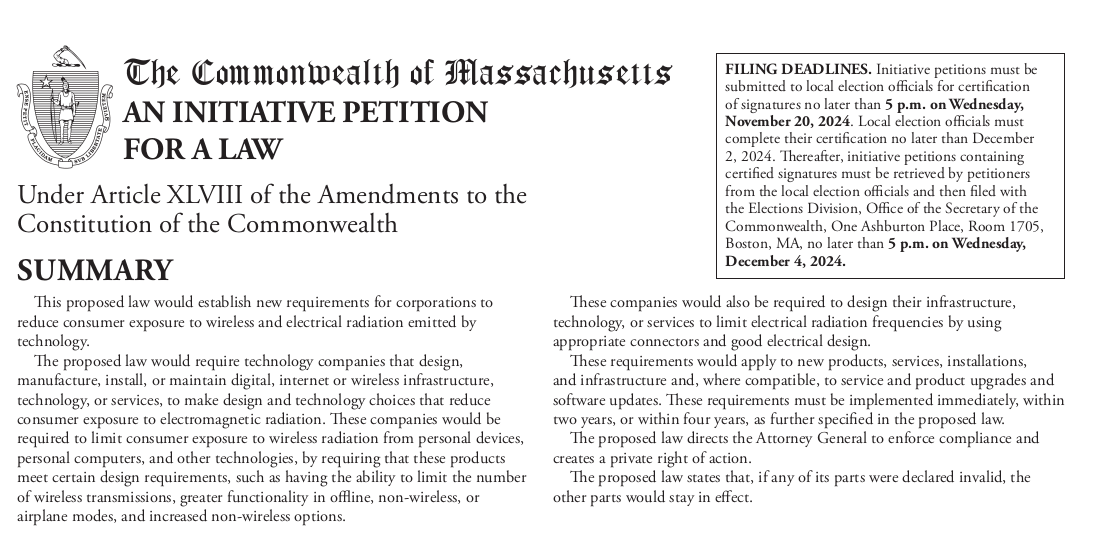The Massachusetts attorney general’s office is required to create summaries for initiative petitions that are concise and accurate, though not necessarily detailed.
The following is the official summary of petition initiative A, for which we are gathering signatures, and below the summary is the text of the proposed law – the attorney general’s office has not yet posted this petition online:
SUMMARY OF PETITION A
This proposed law would establish new requirements for corporations to reduce consumer exposure to wireless and electrical radiation emitted by technology.
The proposed law would require technology companies that design, manufacture, install, or maintain digital, internet or wireless infrastructure, technology, or services, to make design and technology choices that reduce consumer exposure to electromagnetic radiation.
These companies would be required to limit consumer exposure to wireless radiation from personal devices, personal computers, and other technologies, by requiring that these products meet certain design requirements, such as having the ability to limit the number of wireless transmissions, greater functionality in offline, non-wireless, or airplane modes, and increased non-wireless options.
These companies would also be required to design their infrastructure, technology, or services to limit electrical radiation frequencies by using appropriate connectors and good electrical design.
These requirements would apply to new products, services, installations, and infrastructure and, where compatible, to service and product upgrades and software updates. These requirements must be implemented immediately, within two years, or within four years, as further specified in the proposed law.
The proposed law directs the Attorney General to enforce compliance and creates a private right of action.
The proposed law states that, if any of its parts were declared invalid, the other parts would stay in effect.
FULL TEXT OF 24-01 INITIATIVE PETITION FOR A LAW RELATIVE TO CORPORATE RADIATION LIMITS (VERSION A)
Be it enacted by the People, and by their authority:
SECTION 1. The following legislative summary may be removed upon passage of the law.
The purpose of this law is to limit exposures to all radiation emitted by technology by requiring certain corporations to, when able, adjust the design, manufacturing, maintenance and installation of technological products and services. The radiation that is emitted by technology includes wireless radiation and radiative fields from electricity.
Some specific requirements to limit wireless radiation include to limit the number of transmissions; allow greater functionality in offline, hard-wired, or airplane modes; and to provide access to hard-wired options.
Some specific requirements to limit radiative fields from electricity are to use quality electrical design, including filtering out non-60 hertz frequencies.
While other specific limits are provided by the law, relevant corporations are expected be proactive in further researching and applying findings to limit any potential harm from radiation exposure. Prosecution under chapter 93A and chapter 106 is allowed for failure of compliance.
SECTION 2. The General Laws are hereby amended by inserting after chapter 166A the following new chapter:
CHAPTER 166B.
CORPORATE RADIATION LIMITS
Section 1.
(a) As used in this section, the following terms shall have the following meanings:
“As Safe As Reasonable and Achievable” or “ASARAA” means that when humans or the environment are exposed to radiation from technology, the exposure should be as safe as is reasonable and achievable with respect to all software design, installation, and technological aspects, such as with regard to but not limited to non-use (an elimination of exposure), pulsing, modulation, frequencies, resonance, power density, polarization, power quality, distance of reach, shielding, filters, grounding, and synergism between frequencies or other bio-active substances.
“Reasonable” means within the term ASARAA a prioritization of safety and does not refer to a risk and benefits analysis – reasonable refers to the fact that prioritizing safety is reasonable. Reasonable design means that non-use or elimination of radiation applies when a potential for great danger to the public or environment exists as judged by a reasonable interpretation of available science, expert warnings, or when effects are unknown.
“Electromagnetic radiation” or “radiation” means all radiation emitted by technology, whether intentionally or unintentionally, and includes the radiative fields emitted by electricity, including from poor power quality, and the radiating frequencies that are emitted by wireless technologies.
(b) Corporations which design, manufacture, install, or maintain digital, internet, or wireless infrastructure, technology, or their respective services must within their purview make design and technological choices that limit harm from electromagnetic radiation – exposures from technology must be ‘As Safe as Reasonable and Achievable’, which will hereafter be called ‘ASARAA’. Where products or services are actually intended to operate wirelessly or otherwise intentionally emit radiation, such corporations are to minimize harm with ASARAA design.
This directive for ASARAA design refers to all new products, services, installations, infrastructure and, where compatibility exists, to service upgrades, product upgrades, repairs, and ongoing software updates.
(c) General ASARAA design principles and more specific requirements are as follows:
(1) Limit consumer exposure to wireless radiation from personal devices, personal computers, and other radiating technologies including but not limited to the following requirements:
- Provide hard-wired integration options for wireless technologies and services so that any wireless antenna can be turned off when hard-wired transmission is preferred;
- Automatically block wireless radiation emissions, but not reception, when positioned close to the head or body;
- Include a soft key that easily allows all wireless transmissions to be turned on or halted;
- Include a soft key for a mode that only receives and does not transmit;
- Set factory and default mode to wired connectivity, allowing updates, downloads, and installations to occur with wired instead of wireless connectivity and insuring that updates do not restart wireless transmissions that were preset as wired;
- As related to messaging, data collection, and other applications, provide an application that allows consumers to turn off antenna transmissions individually as well as allows consumers to set transmissions to occur at certain times.
- Eliminate continuing transmissions of location so that transmissions only occur when expressly and actively sought by the consumer for an immediate, active use, and that when use appears to stop then inquire whether location service transmissions are still needed.
- Provide an application to turn on location services on remote inquiry in order to find lost mobile devices.
- Set routers, wireless home phones, and other transmitting devices to only transmit on demand and turn off when no longer in use by the consumer.
- With respect to data collection, integration, and related work on the part of the consumer utilizing a mobile device, provide simple, preferential functionality for inputing and collecting data offline and for use of wired connectivity for downloading and syncing onto any pertinent device, including a passive storage device.
- Use automated protocol-based reductions of all of the following: the number of emissions, emission duration, and the integrated dose;
- Providing an easy to access, free application with personal wireless devices to limit call durations according to an estimation of the effective radiated power emitted by the device that allows: (A) consumers to track and further refine call duration limits beyond any default settings; (B) parents to set the limits for their children’s phone.
- Except where only wireless connectivity can provide functionality, insure wired or offline functionality is available and comparable in quality or better than wireless functionality;
- Insure use of quality connectors that prevent leakage of radiation;
- Modify the antenna of personal mobile devices so the emission pattern is more hemispherical and radiates away from the head and the body.
- With new personal computer, cellphone, and other internet technology product sales, provide the connecting necessities, minus an Ethernet cord, for hard-wired functionality as part of the sales package.
- Provide simple, accessible information on how to hard-wire products, including where to get or buy the necessary equipment to do so;
- When installing, programming, or setting up relevant technology, limit radiation wherever possible.
- Limit the reach or distance of and the power density of antennas to only that necessary for functionality.
(2) Limit consumer exposure to electrical radiation with good design including the following requirements:
- Limit electrical radiation frequencies through the use of appropriate filters, connectors, and quality electrical design to prevent the addition of electromagnetic frequencies besides 60 hertz on the electrical linesand to comply with electrical code standard IEEE 519;
- Limit electrical radiation fields through the use of shielding, grounding, distance setbacks, and quality electrical design.
(d) While subsection (c) above provides some specific requirements, the general principal of ASARAA means that corporations have a duty to be proactive in the prevention of harm through continuing investigation and application of findings to further additional modifications for the best, safest, future-proof design. Corporations have a duty to pay attention to critics, cautions and guidance from existing scientific knowledge around the world from past to present in order to craft safer technology – and a duty to avoid ignorance or compromised, inadequate research as an excuse to avoid responsibility. Recommended resources to guide design include the Building Biology Institute and the International Commission on the Biological Effects of Electromagnetic Fields.
(e) The attorney general shall enforce good faith compliance of this section through adjudication of complaints alleging such violations in accordance with chapter 93A and with chapter 106, section 2-314. This remedy shall not be exclusive and shall be in addition to all other causes of action, remedies and penalties provided by law, and shall allow for a qui tam action as well as a private right of action for product liability and negligence. The office of the attorney general shall provide a mechanism for anonymous reporting of violations. Corporate whistle-blowers shall be provided comparable rewards and protections to that of the Massachusetts False Claims Act and the Massachusetts Whistleblower Protection Act.
SECTION 3. The provisions of this act are severable, and if any clause, sentence, paragraph or section of this law or an application thereof shall be adjudged by any court of competent jurisdiction to be invalid, such judgment shall not affect, impair, or invalidate the remainder thereof but shall be confined in its operation to the clause, sentence, paragraph, section or application adjudged invalid and such clause, sentence, paragraph, section or application shall be reformed and construed so that it would be valid to the maximum extent permitted.
SECTION 4. This act shall take effect upon its passage. Upon the effective date of this section, compliance shall be in good faith with steps initiated to implement changes within
a month and changes rolled out as soon as functional. Some changes can take place immediately, such as in the choice of settings and equipment during installation of existing technology. Specific software requirements listed should be enacted at minimum within 2 years, while those requiring manufacturing should at minimum take no more than 4 years to be enacted and should also be reflected in the ongoing design of new models.





